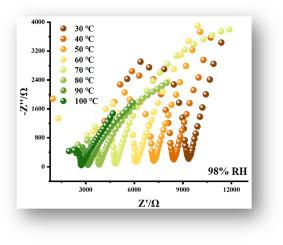High proton conductivity of a three-dimensional Cu(II) supramolecule built by multicarboxylate and N-containing ligands
IF 3.5
3区 化学
Q2 CHEMISTRY, INORGANIC & NUCLEAR
引用次数: 0
Abstract
Recent research has seen a surge in interest toward exploring proton conductivity (σ) in crystalline materials, which combine high crystallinity with diverse physicochemical properties. However, investigations into supramolecular complexes remain limited. Herein, we designed a three-dimensional supramolecular complex, [Cu2(H2L)(phen)2]•2H2O (1), by reacting the imidazole multicarboxylic acid, 2,2'-(1,4-phenyl)bis(1H-imidazole-4,5-dicarboxylic acid) (H6L) with CuCl2 in the presence of 1,10-phenanthroline (phen). Systematic characterization of compound 1 revealed a strong positive correlation between σ and both temperature and relative humidity (RH). Notably, the σ reached a maximum value of 1.87 × 10−3 S cm−1 under 100 °C/98 % RH. These findings highlight the promising potential of such supramolecular complexes for applications in proton exchange membrane fuel cells and other advanced energy technologies. This work not only expands the scope of proton-conductive materials but also paves the way for the rational design of high-performance systems through the use of supramolecular engineering.

由多羧酸盐和含n配体构建的三维Cu(II)超分子的高质子导电性
最近的研究已经看到了对探索晶体材料的质子电导率(σ)的兴趣激增,它结合了高结晶度和不同的物理化学性质。然而,对超分子复合物的研究仍然有限。本文在1,10-菲罗啉(phen)存在下,将咪唑多羧酸2,2′-(1,4-苯基)双(1h -咪唑-4,5-二羧酸)(H6L)与CuCl2反应,设计了一个三维超分子配合物[Cu2(H2L)(phen)2]•2H2O(1)。对化合物1的系统表征表明,σ与温度和相对湿度(RH)均呈正相关。值得注意的是,在100℃/ 98% RH下,σ达到最大值1.87 × 10−3 S cm−1。这些发现突出了这种超分子复合物在质子交换膜燃料电池和其他先进能源技术中的应用前景。这项工作不仅扩大了质子导电材料的范围,而且通过超分子工程的应用为高性能系统的合理设计铺平了道路。
本文章由计算机程序翻译,如有差异,请以英文原文为准。
求助全文
约1分钟内获得全文
求助全文
来源期刊

Journal of Solid State Chemistry
化学-无机化学与核化学
CiteScore
6.00
自引率
9.10%
发文量
848
审稿时长
25 days
期刊介绍:
Covering major developments in the field of solid state chemistry and related areas such as ceramics and amorphous materials, the Journal of Solid State Chemistry features studies of chemical, structural, thermodynamic, electronic, magnetic, and optical properties and processes in solids.
 求助内容:
求助内容: 应助结果提醒方式:
应助结果提醒方式:


